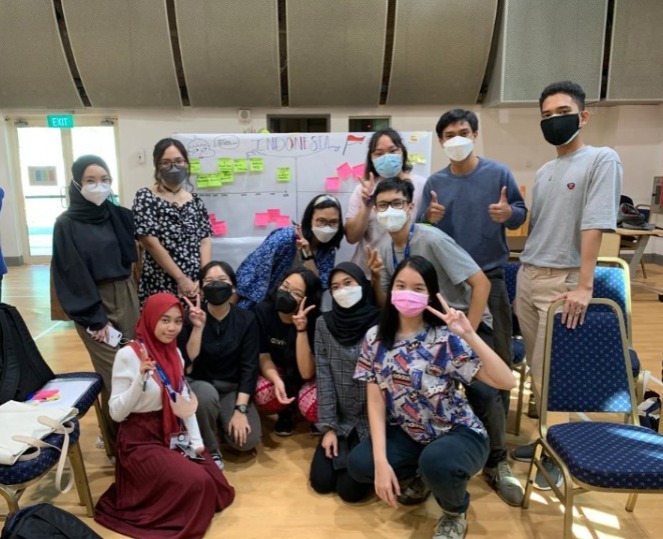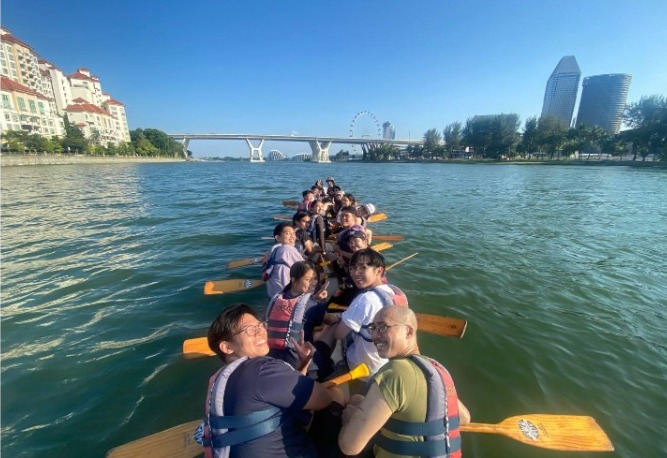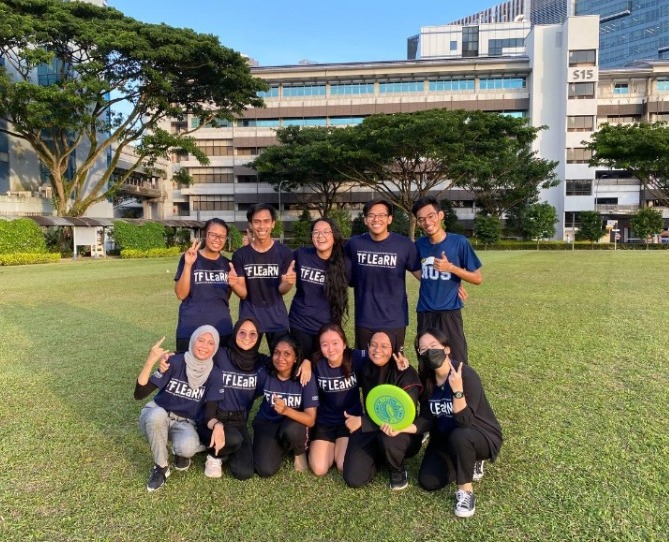About TF-NUS LEaRN
TF-NUS LEaRN is a three-week summer program sponsored by Temasek Foundation at National University of Singapore aiming to nurture the next generation of Asian Leaders by providing opportunities for cultural exchange, networking, and leadership enhancement. TF-NUS LEaRN 2022 focuses on Holistic Resilience, Entrepreneurship, Technology and Innovation. We learned about the registration for this program from our beloved and supporting lecturer, Mba Alva <3. Even so, the information could actually be found on the OIA UGM Website.
Our Experiences
- Experiencing Offline School for The First Time

As we all know, the Covid-19 pandemic has hit the world for over two years. Since the English Department has not conducted offline classes effectively, this program allowed us to experience offline school for the first time after a while. Initially, we doubted our ability to survive the offline classes, especially in NUS. But thanks to our willingness to challenge ourselves, we managed to pass this program satisfactorily by always being active in the classes and group discussions.
- Playing “Kotak Pos” with ASEAN Buddies

In the first week of the program, we had the opportunity to group up according to our nationality. On that day, we (Indonesians) were trying to explain the history of Indonesia from independence day until now. After that, we all gave other countries sticky notes of our hope for their countries. After the sessions were done, we all gathered in a circle to play one of Indonesian traditional games, “Kotak Pos.” At first, everyone who played was only Indonesian, but because we made quite a big noise when we played Kotak Pos, some of the nearest participants started to join us. There, we had fun introducing Kotak Pos to our ASEAN friends, which they found pretty fun too.
- Celebrating Hari Raya Haji with ASEAN Buddies

Luckily we could spend our first Hari Raya Haji in Singapore during this program, which turned out to be celebrated a bit differently from the one in Indonesia. In the morning, we went to pray at Tentera di Raja Mosque, which is quite near PGPR. Before that day, we had to book a place first on the MUIS website. Otherwise, we might not have been allowed to enter the mosque. Also, most Singaporeans don’t conduct slaughter in their own country, yet they celebrate it like Indonesians celebrate Lebaran Day: full of food and family visits! And our Singaporean buddies, Sayyid and Husna, were so open-handed that they invited us to celebrate Hari Raya Haji in their houses! Sayyid’s family served us scrumptious Indian cuisines. There was Naan Bread with Butter Chicken, Roti Jala/Kirai with Mutton Curry, Sayyid Mom’s tasty Fried Chicken, and Chana Masala. Meanwhile, Husna (assisted by another buddy Nafla) cooked Malay cuisines, which were Ketupat, Sambal Goreng Pengantin, Begedil Ball, Vege Tomato Soup, Serondeng, Sambal and Ikan Keeping. We also made Ondeh-ondeh together in her house! Fyi, Ondeh-ondeh in Singapore is the same as Klepon in Indonesia.
- Dragon Boating and Frisbee with Hompimpa😃

There are some fun activities that we did outside the program, one of which was dragon boating. On Buddy Day, a day scheduled for us to spend our time with our own buddy, We and Rahh’s buddy, Nafla, went to Wayne’s house (Raihan’s buddy) to spend our morning till afternoon there before going dragon boating. There we played Monopoly and Uno. After that, at 3 pm, we went to the Kallang Water Sports Center near the Singapore National Stadium. There, we went dragon boating with most of the ASEAN buddies for 2 hours straight. It was also our first time doing dragon boating, so we knew nothing about that. Thankfully there was an instructor that helped us to learn the movement. In dragon boating, synchronized teamwork is essential to make the boat move, and after the instructor told us that we should count synchronously, we were able to slowly move the boat.

We also played frisbee the day before we went dragon boating. It was also our first experience playing frisbee. The funny yet exciting time was when we tried to divide the group into two; no one had any idea what we should do. Suddenly the Indonesians said, “Let’s just do hompimpa!” and we did exactly that. We have fun while also introducing some Indonesian games. It was an enjoyable and exciting moment with everyone.
- Daily Life as Exchange Students in NUS
During the program, we stayed in Prince George’s Park Residence, one of NUS Housing. This accommodation was already sponsored. Because of the complete cooking utensils in the PGPR’s pantry, we loved to cook our own food, mostly for breakfast and lunch. This was also what reduced our expenses there! To go around, we mostly took public transportation, such as the NUS bus, MRT, and public bus. Fyi, the NUS bus is free for the public! And it’s very helpful because it reaches strategic places such as Kent Ridge MRT Station and nearest Fair Price, where we used to buy our groceries.
As Muslims, we didn’t really find any difficulty living in Singapore, especially because we have quite a lot of Muslim buddies in this program. We learned a lot from them, like where they usually pray, how to choose a food stall that sells halal food, and where we can find halal food easily. We found that if there is no mosque or prayer room nearby, it’s very common for Muslims in Singapore to pray on emergency stairs. However, we had a funny experience about it. In our first week, we still didn’t understand where they usually pray in public places. Thus, we prayed in front of the lift in a convention centre, where many people passed. While we were praying, a little boy passed by and returned only to seriously pay attention to us. Quite a memorable experience for us!
Our Impressions on the Program and Singapore:
Rahh
It was only three weeks, but I already feel that half of my soul is still there in Singapore <3. That is the perfect quote to summarize my impression on this exchange experience. I always felt welcome and appreciated, both by local and international folks I met during this program and both in classes and in everyday life. I admit that I still have a lot to learn from them, but they never made me feel inferior. They always appreciated other people for any good thing they did, even how they dressed. Also, I felt so safe in Singapore that I didn’t need to worry too much about myself and my stuff. Going out very early in the morning or returning to the dorm at almost midnight didn’t make me worry about my safety.
Raihan
- About the Program
At first, I thought the program would be too exhausting for me since it was in NUS, but it wasn’t. All the participants were very friendly and always willing to listen to what I said. The material that was discussed also opened my mind. The program wasn’t exhausting because they tried to put on engaging sessions or intermezzo after every severe session. For example, we had a well-being activity which was a tote bag painting workshop. In that session, we painted our tote bag by choosing the design given by the instructor and drawing it onto our tote bag. Even though I needed to use my creativity to hide my lousy drawing on my tote bag in the end, I’m still proud of my work, especially since it was my first experience in painting.
- About NUS
In my view, the NUS area feels quite large, but in real life, each faculty and building were placed relatively close to each other. The thing that makes NUS feel quite large and each building feels a bit far from each other because the campus is located on a hill. Thankfully, there is an NUS bus that I can ride for free from the bus stop around NUS. The downside was the bus driver can get a bit rowdy sometimes, even NUS itself recruiting a mystery rider that will be paid to observe how the bus is being driven. Other than that, NUS campus life is already solid, with the dorm located inside the campus area and the accessibility to public transport from the campus. This is also why I haven’t seen any students driving or riding to the campus in their own vehicles.
- About Singapore
The simplest yet beneficial thing that I learned in Singapore, I call the escalator manner. So, the escalator manner is a manner in which a person who is not in a hurry needs to stay on the left side of the escalator. During the first few days in SG I didn’t know about this, so at the airport and in some other places, like public transport escalators, I stayed on the right the whole time while talking to my friends, which might make some people angry at that time. As time goes by, I’ve implemented this manner already. I even started walking like a Singaporean, which is much faster than most Indonesian people do. The funny thing is when I just came back to Indonesia, these kinds of manners made me a bit angry. On the first day in Jakarta, I went to the mall with Rahh and Jess and while on the escalator, the people there stood anywhere, which was frustrating because the escalator was also way too slow. Even it still happens in the travelator in Soekarno-Hatta Airport, where the signs where people should stand and where people should walk are available. Now, I just wish that this manner can be applied in Indonesia for a good reason.
Other things that also felt much better in SG were public transportation and pedestrian sidewalk. Transportation in SG is much better because all of the public transport lines are nearly connected, especially MRT lines, and all the MRT stations are reachable from anywhere. The sidewalk also feels comfy because there weren’t any food stalls or carts on it. Because of this, I’m starting to get used to walking a lot and love to use public transportation in those three weeks. From only completing 1.3k steps a day to averaging 12k steps a day, my highest steps a day was 20k. In Indonesia, if we want to go across the road, even at the pedestrian cross, the motor users still try to overtake us and sometimes honk like crazy, but in SG, I feel that every time we want to use the pedestrian cross, the motor users will give us the way first without even need to wave our hand as long as you are near the pedestrian crossing.




